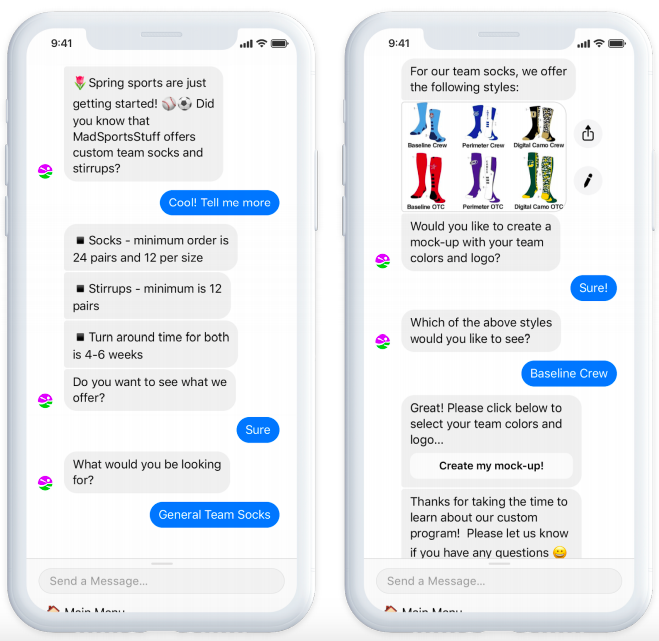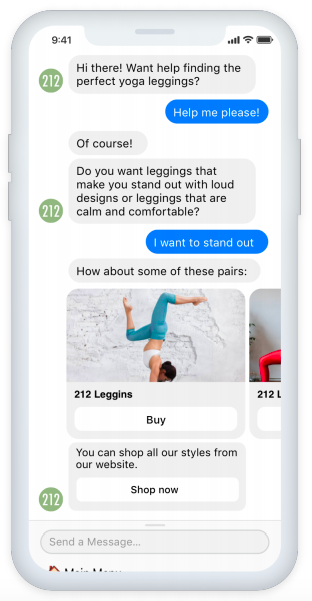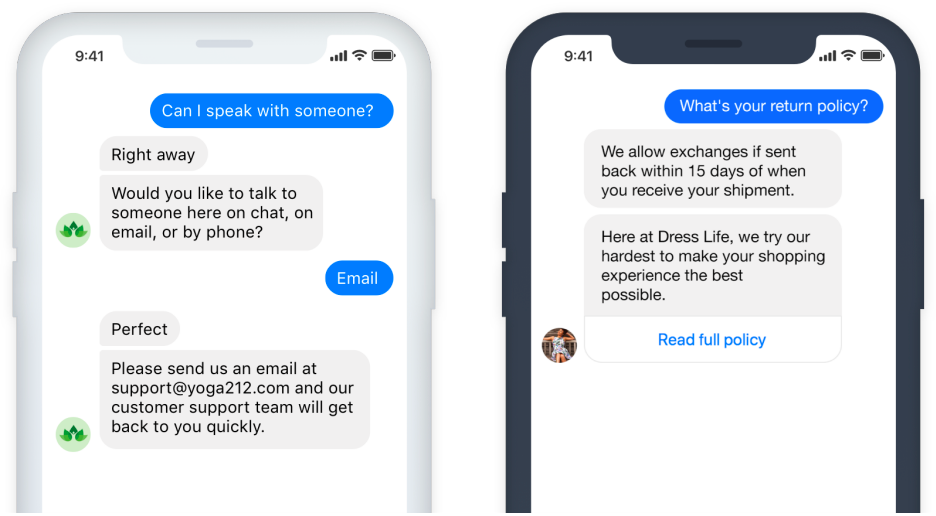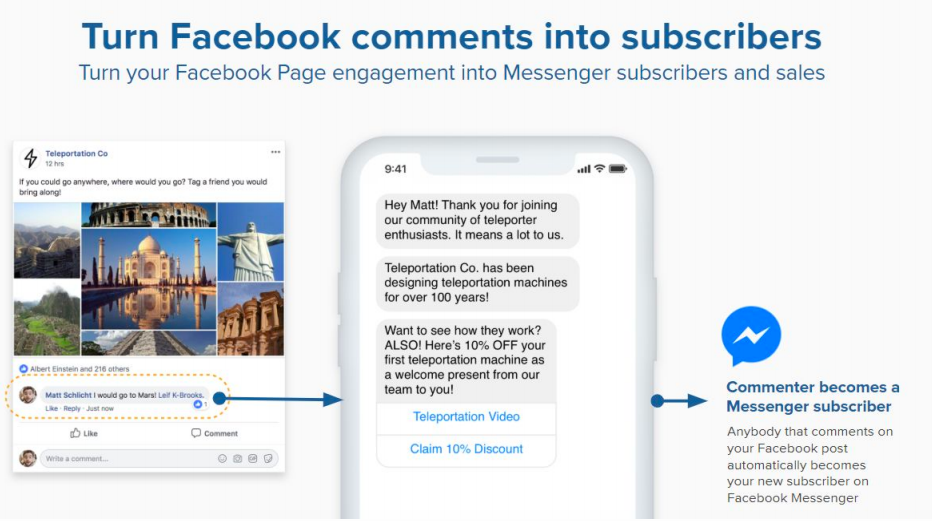Table of Contents
** Minutes
What is conversational commerce?
Popular uses for conversational commerce
The 6 steps of conversational commerce through chatbots
Why is conversational commerce so important?
Conversational commerce on social media
Getting started with conversational commerce, what are you waiting for?
Word-of-mouth advertising is the most important marketing tool in business today. In fact, 92% of people trust recommendations from friends and family over any other type of advertising.
If you’re thinking about that in the context of your own shopping habits, you’re probably realizing that you tend to go to restaurants your friends recommend, watch the shows your friends are watching, and use the same technology your friends do. You trust their recommendations because you trust their taste.
Your business is probably not going to go on bike rides or attend concerts with customers, but that doesn’t mean you can’t connect with them to build a relationship. In the supersaturated world of commerce, it’s essential to make these kinds of connections if you want to scale your business.
To stand out from the crowd, your audience needs to trust your business to make their customer journey as seamless and enjoyable as possible so that every time they’re looking to buy something, they know where to go. One of the best ways to build and leverage this trust is through conversational commerce.
What is conversational commerce?
Conversational commerce refers to commerce that takes place through conversations happening online. Through services like on-site chatbots and messengers, as well as third-party chat apps like Whatsapp, WeChat, and Facebook Messenger, conversational commerce can help consumers find the best product options for their unique needs, all in real-time.
Coined by Uber’s Chris Messina in a 2015 Medium piece, conversational commerce refers to the intersection of messaging apps and shopping. In practice, it relies on a combination of shopping, marketing support through conversational support and customer service to enhance the customer journey and help convert site visitors into buyers at a more scalable rate.
It’s like having a shopping sherpa, guiding you up to the ecommerce mountain.
Popular uses for conversational commerce
So what does conversational commerce look like? Like great word-of-mouth advertising. When you’ve built enough trust with your customers that you can communicate with them in real-time to drive them toward the desired end, that’s a huge win.
Some of the most common uses of conversational commerce are:
- Giving product recommendations
- Helping customers with a purchase
- Providing customer support
- Helping customers customize products
- Answering general questions about a product/service
Each of these uses can effectively leverage the immediacy of the shopping experience, allowing customers to get basic answers fast from artificial intelligence algorithms, or to connect quickly with a person who can answer more specific nuanced questions.
The 6 steps of conversational commerce through chatbots
You know the what and why of conversational commerce, so now it’s time to focus on how a customer navigates through a conversational commerce infrastructure. It’s pretty easy:
1. A user visits your site
Obviously, you need visitors on your site to execute a conversational marketing strategy. Conveniently, conversational commerce doesn’t discriminate between your traffic. Whether a customer is returning organically, through email or Messenger marketing, or is a first-time visitor attracted through an external ad or search, you can connect with anyone via a chatbot.
2. Your chatbot appears
Once a visitor is on your site, your chatbot greets them. You can customize your chatbots to read customer data and address them appropriately based on their previous (or lack thereof) experience with your site. Tools like Octane AI allow you to create as many greetings as you like based on any number of customer factors.
Examples include “Welcome back,” “Welcome to X,” and “Did you miss us?” You can be as cheeky or as serious as you’d like — whatever your brand voice calls for.
3. The chatbot asks a question or sends a promotional message
Chatbots can’t have a conversation unless prompted by the human user, so it’s valuable to start conversations with something actionable and creative in opening messages until you can offer live chat support.
From asking what a customer is looking for or prompting them to retrieve their abandoned cart, to ask them if they’d like to receive a first-time visitor promo code, you can use any number of strategies to start the conversation.
4. The chatbot helps the user
Whether someone is looking for purchase recommendations, needs help regarding a previous order, or wants more information about your product/service, customers can communicate with your chatbot to get their questions answered. No human time or resources needed.


5. The user purchases or finds the help they need
The goal of any conversational commerce interaction is to leave the customer happy and satisfied. This typically means helping answer their questions or resolve their issues as efficiently as possible. Great chatbots, powered by tools like Octane AI, can accelerate resolution time while keeping human employees free to focus on other bigger-picture things.


6. The customer is happy!
Bam! Just like that, an artificial intelligence experience makes a customer happy with the fast and personal service they received. They’re surprised and thrilled by the personalized help they received from a robot, so that when your chatbot asks, “Would you like to leave a review of your experience today?” they happily agree. They leave a glowing review that can be seen by other visitors, enhancing your business’s credibility, improving your CSAT rating, and revolutionizing your site’s customer experience.


Why is conversational commerce so important?
Benefits for customers
- Fast response times
- No need to commute
- Fast shipping
- Tailor-made recommendations from experienced staff
- AI chatbot provide quick solutions with easy to follow instructions
- Safe payment methods
Imagine you’re at a department store the day before Christmas Eve, shopping at the last minute for a new pair of headphones for your dad. The store is woefully understaffed, and you can’t get anyone to tell you if the pair you’re evaluating is noise-canceling, how long the battery life lasts, or the Bluetooth quality.
If you had stayed home and shopped online with a business offering strong conversational commerce solutions, you could get these questions answered almost instantaneously, as well as purchase it with overnight shipping so your dad’s gift arrives on time. The benefits of conversational commerce are countless.
When customers interact with a chatbot on a site to ask for a product recommendation — such as headphones — you have the chance to improve their experience by giving them personal and accurate recommendations. You can answer their questions about your recommendations in detail so they know exactly what they’re getting.


These recommendations show you care about each customer’s tastes and preferences, provide a personal touch, and demonstrate that you’re looking out for their best interest. Conversational commerce can vastly improve your customer relationships.
This kind of easy access to customers improves the sales experience from the outset. Rather than making customers search your site, AI chatbots can greet them instantly, ask them what they’re looking for, and send them in the right direction in seconds. It’s like having an army of Walmart greeters who know the store like the back of their hands and never get overwhelmed when it’s busy. This makes it easy for customers to find what they’re looking for and buy without getting bogged down in superfluous detail.
If the customer does need to know some detail, however, conversational commerce can still help. In addition to delivering recommendations based on your customers’ previous purchases or questions, AI chatbots can assist customers in all aspects of their journey.
Whether they’ve forgotten their password or can’t figure out how to enter the new credit card information, chatbots can help them troubleshoot any points of confusion or site malfunctions.
Benefits for sellers
- Improved customer experience
- Collect online feedback
- Cross-sell opportunities
- Less manual labor
- Data collected across all platforms
- Streamlines brand across all channels
Through conversational commerce, you can direct customers to FAQ pages, help them figure out shipping information like ecommerce order tracking numbers, provide product specs, reset passwords, and much more. This time-effective, responsive help makes the online shopping experience more seamless and keeps customers coming back to you.


Better yet, when customers are clearly just there to browse and do their due diligence about a product, conversational commerce can be a vital lead generation tool. Say you’re selling something more technical than headphones, like a design or marketing suite for small businesses.
You’ve certainly got a lot of competitors and with AI chatbots on your site, you can start a conversation with a visitor, track what they’re asking, and direct serious customers to a salesperson to convert them into a buyer. By combining artificial intelligence and human touch, conversational commerce can produce a 360-degree sales experience that keeps both potential and returning customers completely satisfied.
Conversational commerce on social media
The rise of social commerce has opened new channels to do selling for you through conversational experiences. Chatbots can of course go beyond your site, and to have a really great conversational commerce strategy, they should. One of the best tools to use for this purpose is Facebook Messenger, which is the second most downloaded app ever and ripe with conversational marketing opportunities that keeps customer engagement at an all-time high.
According to information released at Facebook’s F8 conference, Messenger marketing reports 10-80 times better engagement than email, with more than 1.5 billion active users being reached by just 300,000 active chatbots.
Messenger chatbots powered by Octane AI allow you to generate new customers, re-engage dormant customers, remind customers of abandoned carts, keep purchasers apprised of ecommerce shipping information and overall promotes positive customer satisfaction. They offer a conversational commerce experience that extends beyond your site, letting your business have more of a presence in your customers’ lives and providing them an unprecedented quality of service.
Getting started with conversational commerce, what are you waiting for?
Conversational commerce is one of the most effective ways to build trust with ecommerce customers and promote an active relationship that leads to more sales. After all, customers are far more willing to shop at stores and social networks that they or their friends and family trust.
Implementing chatbots on your site and on third-party messaging services like Facebook Messenger using tools like Octane AI can overhaul the way your business supports and markets to customers, contributing to an overall better, more lucrative customer experience.
Want to learn more about converting shoppers and improving customer retention? Download our guide on How to Nail the Customer Experience.



